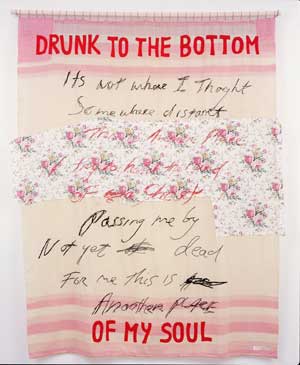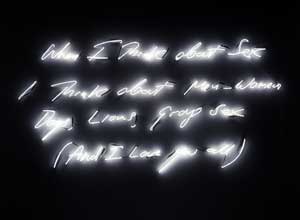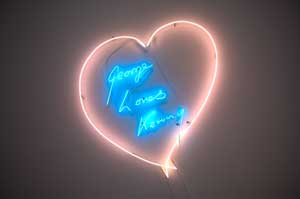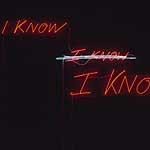Brit artist Tracey Emin is a woman’s woman. She cuts a clear path
through the bush — the weeds of yesterday’s feminism, the “ism” without
which we’d be nowhere.
Emin doesn’t wax philosophical about being a woman. She doesn’t really provide a direction toward a new space of gendered emancipation. Rather it’s that she lives that freedom in her skin in the now — the time of the present. Tawny, pretty and sweet, Emin recasts the feminine according to a new ideal, one so persuasive and charming that a smile was my response to her declaration that “taking a real big shit” would make her headache go away.
At 44, Emin is at the top of her game. Borrowed Light, a broad exhibition of her work, is the mainstay of the British Pavilion at the 52nd Venice Biennale. After Barbara Hepworth, Bridget Riley and Rachel Whiteread, she is the fourth female artist to exhibit in the British Pavilion. Joining a select and largely male list of cohorts, such as the architect Sir John Soane, painter John Constable and sculptor-collagist Sir Eduardo Paolozzi, Emin was made a Royal Academician by the Royal Academy of Arts on March 29, 2007. Emin shows regularly in London at White Cube and in New York at Lehmann Maupin. You Left Me Breathing, an exhibition of sculpture and painting, opens in Los Angeles at Gagosian in November. And she was in Dallas recently to create a performance at the closing of A Tribute to Tracey Emin, the inaugural exhibition of the Goss-Michael Foundation. Famous for work that is risqué and boundary-breaking, Emin lays bare to the world the intimacies of her sexual travails.
With almost dainty pastel watercolors of legs spread wide, her show at Goss-Michael is slightly subtler than usual. Nevertheless, the raucous sexuality of her work as a whole represents a distinct force for female emancipation. Instead of the brainless, candy-colored lewdness of Britney, Emin exerts her sexuality in brash intellectual terms, transforming the traditional woman’s work of sewing into an artist’s tell-all medium. One of her most famous pieces is Everyone I Have Ever Slept With 1963-1995, a blue tent with embroidered panels that was destroyed in the famous fire at the Momart art warehouse in 2004.
Having made installations like My Bed (1998), last night’s pleasures and sorrows registered in her rumple-sheeted bed, surrounded by dirty panties, empty bottles and cigarette butts, and To Meet My Past (2002), a four-poster clad with bedding bearing embroidered poetry, she is an expert of the bed. So it made sense that, addled by a migraine and jet lag, Tracey Emin lay in bed in a room at the Dallas Ritz-Carlton as we spoke.
Charissa Terranova: Your work deals a lot with autobiography — sex and your female identity through sex. I’d like to quote you in an interview with Lynn Barber that was published in The Observer on June 3, 2007:
“When Isabella Blow died, I thought, fucking hell, life is short. It was like a wake-up call. And I realized that I’m 43, I’m probably never going to have children — I would rather have my career than children — which puts me into a very different world to other women, and I intend to live in that world. Even though sex with Scott [her photographer boyfriend] is fantastic, I don’t need it. Relationships are great, but I don’t know how good I am at them. I realized that being an artist is actually quite difficult and I am difficult, and I want to enjoy that difficulty and not feel threatened by it.”
I can say that, personally, I can identify with so much of what you say. Men have been important to you. What happens to your work as your life evolves…away from men?

Tracey Emin...Drunk to the Bottom of My Soul...2002...Appliqué blanket with embroidery...78 3/8 x 63 inches
Tracey Emin: My work is not about men. It is about what I think about men. I grew up feeling no different from men. But education taught me otherwise. You know, I have a twin brother, so that’s part of the reason I’ve never felt less than a man.
CT: Your work has been about your relationships with men, though, hasn’t it?
TE: Yes, but it’s also been about not being in a relationship. I didn’t masturbate for nine months. I didn’t have a relationship for six years. I meet hundreds of men, but it has been difficult to find someone.
CT: Your work is very personal, or shall I say, it is intimate. Would you say your work is more about you or somehow universal?
TE: It is definitely universal. My biggest following is among gay men. They love me because they see me as some kind of heroine. And this is because I am free. I scream, cry and shout. I show my emotions.
CT: What you say, do and make is so important for women — because of your honesty. Do you consider yourself a “feminist”?
TE: Absolutely not. I don’t want to be a man. My work is feminine. Feminism was a historically specific movement that opened the door for people like me to walk through. My work is influenced by Egon Schiele and Edvard Munch. I am feminine. I like nice clothes, and unfortunately a lot of people don’t take me seriously because of this. I made a TV program on women artists. You know, the work done by female artists is cheap…it’s not nearly as valuable as the work done by men.
CT: Sexuality is at the center of your work. Are you a very sexual person?
TE: Definitely. I think I am more sexual than other women. This is a result of many things. I started masturbating when I was eight. In my 20s I was sexually abused in a relationship. So, I’ve been through a lot.
CT: With that said, you do reference a lot of men in your work — boyfriends and male relatives. What about your mother?
TE: About 20 years ago, I did a series of drawings of my mom and grandmother. I made a video of a conversation with my mother where she’s telling me why I shouldn’t have children. My mom is really a strong woman. She is 79 but looks 65. She doesn’t have a doorbell on her door because she has a theory: If you’re going to have a visitor, you’ll know it beforehand. Excuse me…I have to make a go at it.
[Emin darts to the bathroom to vomit and returns.]
CT: Are you okay?
TE: Yes, I just have jet lag and a headache. It hurts right here [pressing on her eyebrow above her left eye].
CT: I think you have a migraine.
TE: It feels better when I vomit. And, you know what, when I have a headache like this, it feels really good to take a really big shit. There’s something about relieving the pressure.
CT: I get migraines too. I know vomiting helps, but shitting hasn’t done the trick for me. Let’s talk about Dallas. Have you been here before?
TE: No. It’s my first time.
CT: Do you know what’s going on here currently? There’s an explosion in the art world — lots of good contemporary art in all kinds of new media are being collected and shown, and amazingly important buildings are going up.
TE: Dallas is great. I am glad to be here, because now I’ve been in the place that was the basis for the TV show Dallas, and I know it’s a lot different. Dallas is great because it has money and space. It’s a very friendly place. After 9-11, Americans have become more distrustful of people. But just being in the airport here, people seemed very friendly.
CT: Do you think you’ll come back?
TE: Yes, I’d like to. But I really shouldn’t travel too much. I am building a library in Uganda, so I am there a lot. My cat, Docket, however, doesn’t like that very much. He doesn’t like me to travel.
CT: I love cats. I have three, one that’s missing an eye.
TE: Docket had a broken leg, and I had to cage him for a while so he could heal. Before the injury, he was like a dog. He’d follow me up and down the stairs. But now he is a little different. It’s like he has Stockholm syndrome. He loves me even more and doesn’t leave me alone.
CT: So, let’s talk about your work now. What are you up to?

Tracey Emin...When I think About Sex I think about Men, Women,...Dogs, Lions, Group Sex, (and I Love You All)...2005...Edition 1/3...Neon...Dimensions Variable
TE: I have a show at Gagosian in Los Angeles opening November 2. I am really happy about the work. I have made these mad paintings, abstract sculpture, stream-of-consciousness drawings. The sculptures are made of wood, gessomite and white neon lights.
CT: How has the Biennale changed your life? Well, it’s still going on now, so your life is changing now.
TE: Yes, it’s been fabulous. The opening week was the best week of my life. I renovated the [British] Pavilion. Jay Joplin took me to lunch with Elton John. Gagosian had a party for me and Fatboy Slim deejayed. And then I had a mouse party. Life is good. The 40s are fantastic. I’d like children and am looking for the right person.
CT: Well, thank you for the interview. You make me want to write.
TE: That’s great… But you’ll have to excuse me.
[Emin darts again to the bathroom.]
CT: [Walking out] Thanks again for the interview. It was great to meet you!
Images courtesy Goss-Michael Foundation
Charissa N. Terranova is the Assistant Professor of Aesthetic Studies
at UTD and the Director of the UTD Artists Residency Program.







